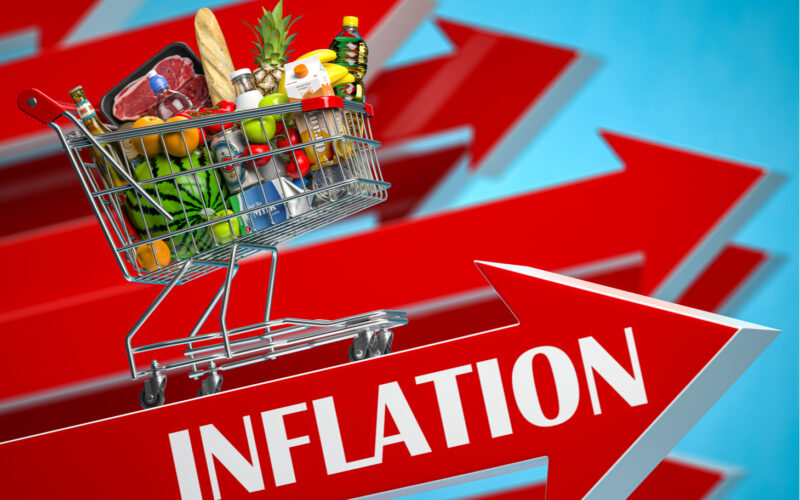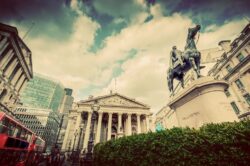I recently interviewed Degussa chief economist Thorsten Polleit about inflation. One of his predictions was for persistently high, but not necessarily out of control, inflation. The underlying idea is known as financial repression.
But I’m not so sure I agree with Polleit’s predictions. Today, I’ll dig into why.
But first, you need to understand why financial repression is so desirable, from a government’s point of view, in the first place. Why do politicians want the combination of high inflation and low interest rates, despite the misery this dishes out to investors and savers… and the voters who elect them?
If inflation tracks along at around 7% for a few years, as some at the Bank of England are predicting will already happen this year, this devalues money rapidly. Debt, being denominated in money, becomes worth less over time.
Thus, if the government is overindebted because of, say a pandemic, (but usually a war, historically speaking), one potential policy is to let inflation rip for a while to get that debt back under control.
If inflation roars at 7% a year for four years, this cuts the debt burden by almost a quarter. That’s an impressive feat which would make any Taxpayer Alliance think tank have a heart attack if anyone proposed doing it the honest… more honest… way of raising taxes.
So, given the impossible debt levels which governments find themselves in, plenty of economists are expecting governments to take the deliberate inflation route. And, so far, it’s what’s playing out too.
Central banks are not just allowing inflation to run away, they’re causing it too, with absurdly low interest rates and huge quantitative easing (QE – the process of buying bonds with money that is essentially created out of thin air). Any reasonable reading of central bank inflation mandates would imply far tighter monetary policy, as John Butler and I discussed yesterday.
The challenge for financial repression, and how it gets its name, is that it shouldn’t be possible to pull off at all. Lenders to the government are not supposed to put up with interest rates 4% below the rate of inflation.
Inflation at 7% and bond yields at 1.5% is the equivalent of handing over 5.5% of your purchasing power to the government every year. Plus taxes on the minimal interest you get to add insult to injury.
This is why bonds are supposed to crash in price if central banks let inflation rise. This crash causes bond yields to rise and the government’s interest bill to spike. This rising bill should offset any reduction in the debt level that comes from letting inflation rip. And so financial repression should be impossible… in a free market.
Indeed, government bonds in many places are plunging in price, causing yields and interest rates on new borrowing to spike. Bond investors are getting cold feet.
But under financial repression, interest rates are kept low artificially – repressed, you might say. Specifically, they are kept below the rate of inflation. That’s how the government gets ahead. Inflation above interest rates allows the value of debt to fall without having to pay the corresponding price in higher interest.
There are several ways to achieve this pinning of the interest rate. One is via capital controls and the other is via the monetary policies of central banks.
Under capital controls, companies and people are forced to own government bonds, which creates artificial demand for them. For example, the Basel rules on banking heavily incentivise holding government debt. And a similar regime applies for insurance companies. The rules classify government bonds as “low risk” and this makes them popular.
The central bank angle is the one we saw most of during the pandemic. Central banks bought government bonds in massive quantities: bond prices were kept up and bond yields were kept down, despite the growing inflation.
Bloomberg recently reported on the Bank of Japan (i.e. that country’s central bank), which puts the policies of financial repression on display:
Japan’s government bond yields are edging toward the upper limit of the central bank’s tolerance level, setting the stage for it to intervene with the first unscheduled debt purchases in two years.
As the 10-year yield approaches the 0.25% mark, the Bank of Japan also has other bond-buying operations at its disposal in any bid to cap yields. It could boost scheduled purchases or buy an unlimited amount of bonds at a fixed rate in a repeat of what happened in July 2018.
Phrases like “cap yields”, “upper limit” and “tolerance level” are examples of financial repression – keeping rates low in the face of higher inflation. Not that Japan has seen this inflation, yet.
The fear is what happens when central banks withdraw their stimulus because of inflation. Where does this leave the old policies which were propping up government debt?
Andrew Sheets from the investment bank Morgan Stanley pointed out that, “From May 2022 to May 2023, Morgan Stanley economists expect G4 central bank balance sheets to shrink by US$2 trillion, four times the largest 12-month decline ever, from 2018-19.” You will recall that 2018-19 was a rough time for bond markets, to put it mildly.
So, we’re talking about a potential return to the worst of the European sovereign debt crisis. But that’s another story.
Here’s my problem with the idea that financial repression will work this time around.
First, remember that it worked after World War II, for example – and during the 1970s, to a lesser extent. Debt was inflated away without bond yields getting out of the central banks’ control. Nevertheless, central banks did have to increase official interest rates to restrain inflation.
But to believe this inflation policy will work again assigns an odd amount of competency and trust to politicians, and an odd amount of apathy to the voting population.
You see, people have now discovered that governments can be financed by central banks. Thanks to the emergency policies of 2008 and 2020, the free-lunch box of the fiat money system has been opened. And people like what they see inside it. And, liking what they see, they won’t want to close it.
If money can be printed to fund government to save us from a banking crisis and a pandemic, then why not from climate change, poverty and cancer?
Financial repression only works under the presumption that the fiscal deficit will normalise at some point in the future. The presumption is that government spending and deficits will come down to a more stable level. Then the debt will have been inflated away and the government will run a stable budget which no longer needs to be monetised. And then, finally, inflation can be brought back under control too.
In the past, the story went something like this: “We used debt to win a war, then resorted to inflation to inflate it away, but now the emergencies are over and normality must return.”
But do you think pitching a return to normality (read austerity) will win politically? Is inflation worse than climate change, poverty or death on an NHS waiting list?
What if the realisation goes the other way this time? What if people demand persistent financing of deficits by central banks? What if we find a permanent sequence of emergencies that all justify central bank financing of deficits?
In that case, the answer is… you get a lot of inflation.
The only good news is that governments might find it a lot harder to actually implement effective control of the monetary system any more.
What makes this latest attempt at financial repression especially interesting is its new weak point. The means of escape which didn’t exist in the past.
And, if you ask me, that means of escape is going to become as important to people’s daily life as foreign currency was in central Europe in 1920.

Nick Hubble
Editor, Fortune & Freedom




